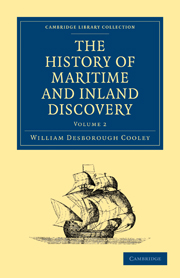Book contents
- Frontmatter
- Contents
- CHAP. I COLUMBUS
- CHAP. II COLUMBUS AND AMERIGO VESPUCCI
- CHAP. III EARLY DISCOVERIES IN AMERICA
- CHAP. IV SPANISH DISCOVERIES, AND FIRST CIRCUMNAVIGATION OF THE EARTH
- CHAP. V FERNANDO CORTEZ
- CHAP. VI CONQUEST OF PERU
- CHAP. VII CONQUESTS OF THE SPANIARDS
- CHAP. VIII CONQUESTS OF THE PORTUGUESE
- CHAP. IX FERDINAND MENDEZ PINTO
- CHAP. X VOYAGES TO THE NORTH
- CHAP. XI VOYAGES TO THE NORTH
- CHAP. XII VOYAGES TO THE NORTH
- CHAP. XIII SETTLEMENTS IN THE EAST
- CHAP. XIV SETTLEMENTS IN NORTH AMERICA
- CHAP. XV ESTABLISHMENTS IN AFRICA
- CHAP. XVI VOYAGES TO THE SOUTH SEA
- CHAP. XVII VOYAGES TO THE SOUTH SEA
- CHAP. XVIII VOYAGES IN THE PACIFIC, AND DISCOVERY OF AUSTRALIA
- CHAP. XIX EXPEDITIONS OF THE BUCCANEERS IN THE SOUTH SEAS
- CHAP. XX VOYAGES OF PRIVATEERS AND OTHERS TO THE SOUTH SEA
- CHAP. XXI DISCOVERIES OF THE RUSSIANS
- CHAP. XXII DISCOVERIES OF THE RUSSIANS
CHAP. IV - SPANISH DISCOVERIES, AND FIRST CIRCUMNAVIGATION OF THE EARTH
Published online by Cambridge University Press: 05 October 2010
- Frontmatter
- Contents
- CHAP. I COLUMBUS
- CHAP. II COLUMBUS AND AMERIGO VESPUCCI
- CHAP. III EARLY DISCOVERIES IN AMERICA
- CHAP. IV SPANISH DISCOVERIES, AND FIRST CIRCUMNAVIGATION OF THE EARTH
- CHAP. V FERNANDO CORTEZ
- CHAP. VI CONQUEST OF PERU
- CHAP. VII CONQUESTS OF THE SPANIARDS
- CHAP. VIII CONQUESTS OF THE PORTUGUESE
- CHAP. IX FERDINAND MENDEZ PINTO
- CHAP. X VOYAGES TO THE NORTH
- CHAP. XI VOYAGES TO THE NORTH
- CHAP. XII VOYAGES TO THE NORTH
- CHAP. XIII SETTLEMENTS IN THE EAST
- CHAP. XIV SETTLEMENTS IN NORTH AMERICA
- CHAP. XV ESTABLISHMENTS IN AFRICA
- CHAP. XVI VOYAGES TO THE SOUTH SEA
- CHAP. XVII VOYAGES TO THE SOUTH SEA
- CHAP. XVIII VOYAGES IN THE PACIFIC, AND DISCOVERY OF AUSTRALIA
- CHAP. XIX EXPEDITIONS OF THE BUCCANEERS IN THE SOUTH SEAS
- CHAP. XX VOYAGES OF PRIVATEERS AND OTHERS TO THE SOUTH SEA
- CHAP. XXI DISCOVERIES OF THE RUSSIANS
- CHAP. XXII DISCOVERIES OF THE RUSSIANS
Summary
During these transactions on the southern continent, the spirit of discovery was actively at work in other quarters. Diego Columbus, the son of the celebrated admiral, had arrived, in 1509, at Hispaniola, invested with all those powers and prerogatives which had been so unjustly withheld from his father. He was followed to the New World by a large train of noble and wealthy persons, whose presence gave new animation and vigour to the colonies. Settlements were made in Cuba and other islands, and expeditions to examine the neighbouring seas proceeded advantageously from different points at once. In 1512, Juan Ponce de Leon, governor of Porto Rico, fitted out three ships to go in search of Bayuca, an island, in which was a fountain, as the Indians related, possessing the virtue of restoring all who bathed in it to youth. Tales such as this were readily believed by romantic adventurers. Those who had braved the perils of the ocean to seek their fortunes in a new world fancied that they trod on enchanted ground; and where nature appeared in so new a garb, the invariable laws by which she directs her operations were easily lost sight of. Ponce de Leon failed to discover the miraculous fountain; but, after sailing a considerable distance to the north-west, he fell in with land, to which, from the circumstance of its being discovered on Easter-day, he gave the name of Florida.
- Type
- Chapter
- Information
- The History of Maritime and Inland Discovery , pp. 42 - 53Publisher: Cambridge University PressPrint publication year: 2010First published in: 1830

